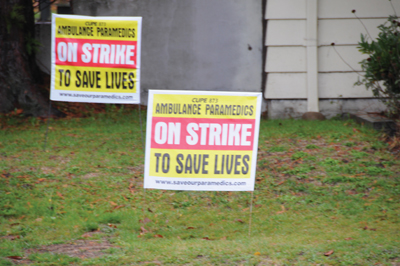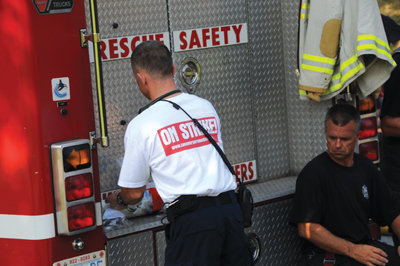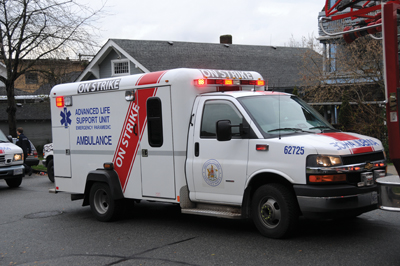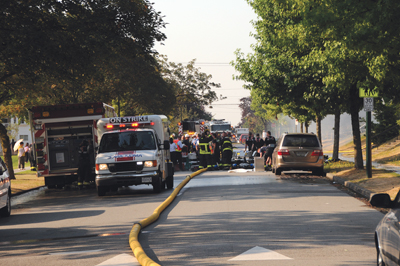
Features
Hot topics
Labour relations
Back to work
In October 1909, Vancouver took its first motorized ambulance out for a test drive and ran over and killed an American tourist. A little more than 100 years later, in the early morning hours of Nov. 7, 2009, the British Columbia legislature passed Bill 21, ending a six-month strike by B.C.’s 3,600 ambulance paramedics. The strike was largely ignored by government until its potential impact on the Vancouver Olympics became front-page news in early November.
 |
|
| Photo by Paul Dixon. The B.C. government showed little interest in the six-month BC Ambulance Service strike until its potential impact on the 2010 Olympics in February became front-page news. |
The strike had little apparent effect on day-to-day ambulance service, as virtually all employees of the British Columbia Ambulance Service (BCAS) were declared by the Labour Relations Board to be essential; mandated overtime was used to cover many open shifts. To the general public, the only indication of a strike was the “On strike” placards displayed on many ambulances.
The strike
One of the keys to establishing a professional, province-wide ambulance service in B.C. in the 1970s was to increase basic qualifications, which led to commensurate pay levels. Initially, pay rates for paramedics were close to those for police and firefighters, but today the union claims that the rates are 25 per cent lower than they should be. BC Ambulance management counters that BCAS pay rates are within “a dollar an hour” of paramedics in Toronto, Edmonton, Calgary and other major cities.
B.J. Chute, spokesman for CUPE 873, said in an interview that even the employer acknowledges a shortage of about 100 full-time equivalent positions in the Lower Mainland region, while the union says the number is closer to 200.
“The ambulance service has become totally dependent on overtime to mask chronic staffing shortages,” Chute said.
The provincial government showed no inclination to get involved in the strike until the potential impact on the 2010 Olympics became an issue. A letter from the Vancouver Olympic Committee (VANOC) to the province dated Sept. 14 was leaked to the media at the beginning of November as the Liberal government was using the H1N1 threat as the pretext behind the imposed back-to-work legislation. That was quickly blown out of the water when, in the letter, Dr. Mike Wilkinson, director of medical services for VANOC, stated: “Without full emergency services on site at the competition venues, the Vancouver 2010 Olympic and Paralympic Winter Games may not proceed.”
Wilkinson further demanded “definitive confirmation” by Oct. 1 that required ambulance services would be provided at all Olympic venues or he said VANOC would be “forced to try to run its own ambulance service or bring in outsiders”. Earlier in the year, BCAS spokesman Steve Roberts had said that between 125 and 150 BCAS paramedics would be required inside Olympic venues on any given day.
On Saturday, Nov. 7, after four days of debate and an all night sitting of the legislature, the government imposed a new one-year contract on the paramedics. Provincial Minister of Health Kevin Falcon resolutely maintained that H1N1 and the “approaching holiday season” were the determining factors in forcing through Bill 21, but finally admitted after the bill passed that the Olympics were indeed a “factor.” On Friday, Nov. 6, the day before Bill 21 was passed, more than 200 angry paramedics picketed outside VANOC offices in east end Vancouver.
 |
|
 |
|
| Photos by Paul Dixon. The strike had little apparent effect on day-to-day ambulance service. The only indication of a strike was the “On strike” t-shirts worn by BCAS workers and placards displayed on many ambulances. |
Lee Doney, BCAS CEO, was quoted in the Globe and Mail on Nov. 14 describing the widespread absenteeism as a planned illegal job action and urging paramedics to return to work. “I appreciate that they are frustrated,” he said. “I appreciate that they didn’t want an end to the strike in this way, but there are other ways to protest than to put patients at risk.”
The union distanced itself from any involvement in the weekend scheduling issues. Barry O’Neill, president of CUPE BC, was quoted by local media as saying there was no organized job action and workers were likely not showing up for work “because they are sick or exhausted because of long hours of overtime (worked during the strike).”
After jousting through the media in the days after the resolution of the strike, both sides in the dispute appear to have gone to ground. (We were unable to get any response to requests for interviews from management or the union.)
In a poll of local fire departments to gauge the impact from the perspective of first responders, Vancouver Fire & Rescue Services and Surrey Fire Rescue Service, the two largest departments in the province, reported no degradation in service.
“Throughout the labour dispute, Vancouver Fire and BCAS have maintained a professional working relationship and have continued to offer all citizens the best EMS care possible,” said Capt. Gabe Roder of VFRS.
That was echoed by Deputy Chief Dan Barnscher of Surrey FRS: “We did not experience any adverse affects from the BCAS strike. Our volume of medical calls is always high, and there did not appear to be much change during the strike.”
The irony of the strike is that hiring and training were suspended for the duration as being “non-essential”. If BCAS had problems with staffing levels as asserted by the union the situation can only be worse now.
The background
That first Vancouver ambulance – the one that killed a pedestrian back in 1909 – was operated by the police department, as were many ambulance services across Canada. For much of the 20th century, ambulance services in British Columbia were operated by an assortment of private contractors, volunteer societies and funeral home operators.
In 1973, the B.C. government commissioned Dr. Richard Foulkes to investigate emergency medical services in the province. The Foulkes Report stated that “emergency services seen in total, encompass many aspects: the level of first aid training of citizens, the adequacy of emergency vehicles and the training of those who operate them, the status of [hospital] emergency departments and in-patient facilities in hospitals and the level of training and availability of those necessary to staff these areas.”
Foulkes continued, “there are in the province variable degrees of quantity and quality of all these components. There is no consensus on the content of training programs or the major source of much of this type of education. Any person that has a Class 4 drivers license can operate any type of vehicle that he wishes and call it an ambulance and without any special training for the job whatever!”
(The Foulkes Report, incidentally, came at a time when the existing emergency services in Canada – police and fire – were making the change from “jobs” to “careers.” As professional qualifications were established, rates of remuneration rose accordingly. Foulkes and Cain both placed pre-hospital emergency medical care – referred to as paramedics or ambulance – on the same plateau as police and firefighters.)
 |
|
| Photo by Paul Dixon. The imposed contract for BCAS workers expires March 31, after the Olympics but just weeks away. |
In larger communities with contracted, professional ambulance services, some fire departments operated inhalator squads that augmented ambulance service, while in many smaller communities the ambulance was operated by the local fire departments.
The BC Ambulance Service was born out of the Foulkes Report, under the umbrella of the Emergency Health Services Commission (EHS) as empowered by the Emergency Health Services Act. BC Ambulance Service came into being on July 4, 1974. Standards of training and expertise were created that could be applied to all regions of the province, from basic entry level requirements for those working in remote areas to the highly skilled advance life support level paramedic working in urban core areas. The Justice Institute of BC, created by the same government as the training facility for law enforcement and fire fighting personnel in the province, was responsible for training emergency medical personnel through its Paramedic Academy. Standardized ambulances, based on the Dodge Kary Van, appeared across the province in the BCAS red and white colours.
In 1989, the chief coroner of the province of B.C., Vince Cain, was commissioned by the provincial Ministry of Health to conduct a review of pre-hospital care in the province. The Cain Report received many submissions, offered observations on the state of affairs and made a number of recommendations. Cain recognized a generally positive working relationship among fire departments and BCAS across the province, noting that where people were pro-active and made a concerted effort to work together it was possible, though there were instances noted where people from both sides of the equation took extraordinary steps to maintain a negative atmosphere.
Cain provided the next step in formalizing the role of first responders within the emergency medical response umbrella. Up to that time, firefighters in the province received a mix of St. Johns and Industrial First Aid. Workers Compensation Board regulations mandated the number of firefighters requiring an IFA ticket, but that was solely related to the workplace and not to the first responder role. The First Responder program was created, with training and certification through the Justice Institute. Today there are more than 7,000 registered first responders in the province, the vast majority being firefighters, both volunteer and career.
The reality
Today, there are 192 BC Ambulance stations across the province and more than 3,600 paramedics, with about 2,200 in part-time, on-call positions. As with prospective firefighters now required to obtain their NFPA 1001 Level 1 and 2 at their own expense to be considered for employment, BCAS requires prospective employees to have obtained, at a minimum, an Emergency Medical Responder licence to work in rural and remote stations prior to engagement. To work in the Lower Mainland region, a Primary Care Paramedic (PCP) licence is a minimum requirement.
In articulating the situation in 1973, Dr. Foulkes stated, “to a large extent the ‘backwardness’ of this province in developing a proper system must be blamed on the attitude towards this subject by the previous government. It appears that it was a deliberately stated policy that they were not going to get involved. That is, without doubt, the cause of the present confusion.”
Bill 21 is not the end of the story, nor even one chapter in the long history of pre-hospital emergency medical care in B.C. It is simply a subplot in a sometimes bitter and acrimonious relationship between labour and management that happened to rear its ugly head just months before the 2010 Olympic Games
The term of the imposed contract expires on March 31 – well after the Olympics have left town. What then?
January 8, 2010
By Paul Dixon
Print this page
Advertisement
Stories continue below
Related